
“The Johari Window Model is really effective!”
I am sure you have heard (or read) something similar somewhere.
…and that’s why you are here, reading this article.
Well, to first put your guesswork to rest: YES, it works but only when you are operating in a true and honest environment.
Why? What? When? How?
All your questions are answered below.
Let’s first begin with.
What is the Johari Window Model?
Summary
A model with four quadrants designed to improve self-awareness and mutual understanding among different individuals in a team is called Johari Window Model.
Johari Window Model, from the crux, is a model of interpersonal awareness that also helps people determine their ability to work with others. Sometimes, it is also used to develop an entire group’s relationship with other group members.
In the Johari model, every person is represented by a window with four panes (detailed explanation on this later in the article). Through these four quadrants, it helps us understand how we see ourselves and how others see us.
Before we dive into detailed explanations, let’s first take
A Peek into the History
The Johari Model was introduced by the American psychologists Joseph Luft and Harry Ingham in 1955 while researching group dynamics during their times in the University of California, Los Angeles.
First published in 1955 in the proceedings of the Western Training Laboratory in Group Development by UCLA Extension Office, Johari Model was later further researched by Joseph Luft.
The name ‘Johari’ was coined by the first names of Joseph Luft and Harrington Ingham, that is, Joe and Harry. Infact, the term was so clearly highlighted that in the early publications it was named ‘JoHari’. Gradually, this model became popular among the common masses also for various reasons like: personal development, improving communication skills, team development, and several others.
Now that you know the definition and the history, it’s time to dive deep…
The Johari Window Model [Detailed Explanation]
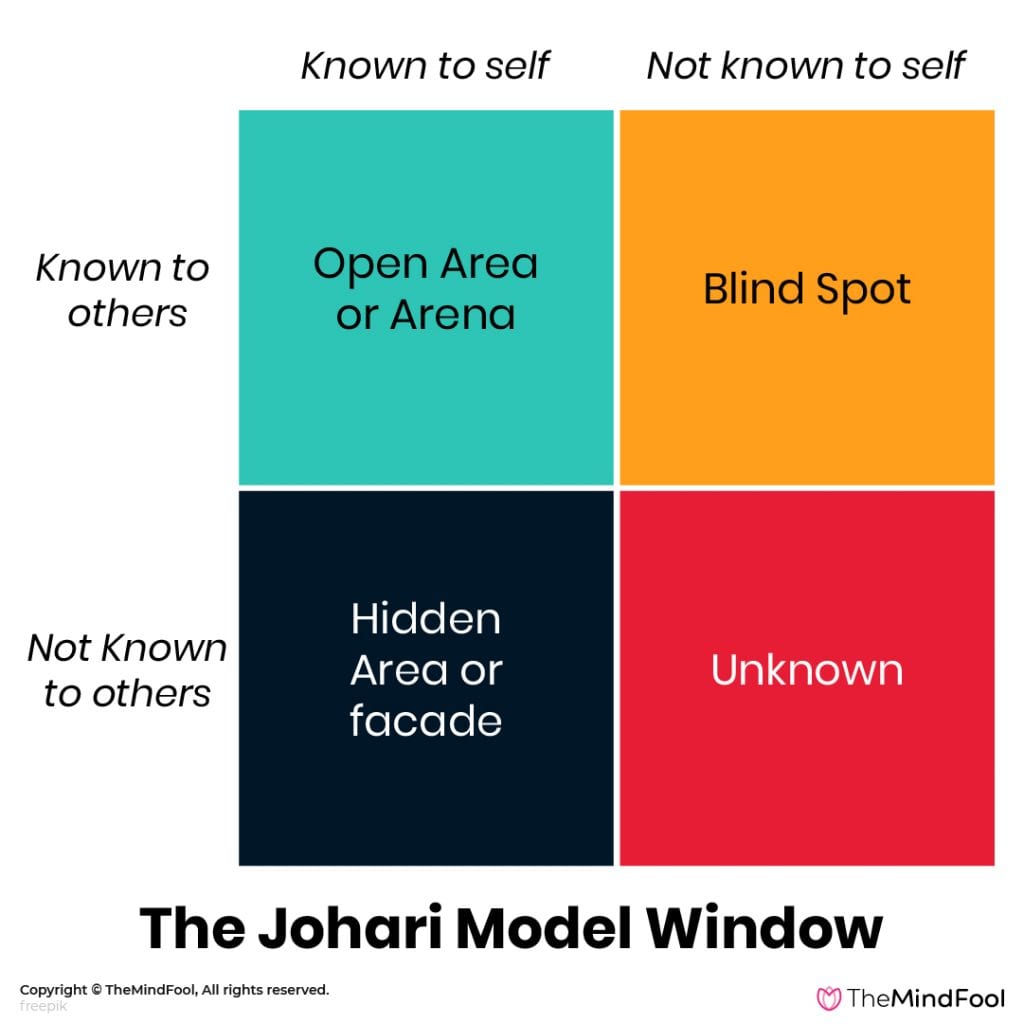
The Johari Window, a graphic model is based on a four-square grid representing four combinations of the information known and unknown to oneself and others. So, here are the four regions of the Johari Model:
Quadrant 1: Open Area or Public Area or Free Area or Self Area or Arena
Summary
The part of information about self that is known to both, you and others is known as Open Area or the Open Quadrant.
The first quadrant in the diagram represents all the information about a person – feelings, expertise, experience, motivation, views, skills, behavior, etc – that is known to both, the person and the others.
NOTE
The process of seeking and receiving feedback which often occurs in this quadrant is called feedback solicitation.
Things you must know about Open Area
- It is also known as the area of free activity or The Arena as this space promotes open communication and cooperation eliminating all sorts of mistrust, confusion, or misunderstanding.
- All the members of the group must always aim to maximize this open space because while working in this open window, the productivity level is the highest for all the team members and of the group as a whole.
- Senior or established team members have larger open areas in contrast to the relatively new team members. This is because relatively less knowledge is shared about the new joinees.
- The size of the open space of the junior team members can be expanded horizontally to the blind area or even vertically downwards to the hidden area by soliciting feedback from the other members or by disclosure of personal information by the person.
- Further, the group members can also help expand the open window of others by asking more about each other. Leaders can also further go out of their way to give personal feedback to facilitate personal growth of the individual.
- Team leaders are also expected to create and promote an open, honest, and helpful working environment and also build trust among the members. All successful and leading organizations have one thing in common: A culture of open positive communication.
Quadrant 2: Blind Self or Blind Area or Blind Spot
Summary
The part of information about self that is only known to others and is unknown to self is known as Blind Area or Blind Quadrant.
The second quadrant in the diagram represents all the information about people who know about you while you are still unaware of it.
NOTE
Team leaders and other group members can help reduce the blind area alongside expanding the open area of an individual – by giving productive feedback.
Things you must know about Blind Area
- Group members must aim to reduce the size of this window and expand the open area by seeking feedback from others.
- The blind area is infamous for productivity and the person with the greater blind area is often referred to as ignorant self. It is also comparatively less effective than any other area as you are entirely lost in your own issues.
- This area also represents information of that person that is deliberately held by other people. It further emphasizes all the problems that are triggered by withholding information from the people
- Team leaders or managers try to create an environment where the received feedback is accepted without any fear. Further, they also motivate other group members to give feedback without any judgments or biases.
- However, managers must always seek the individual’s discretion to determine the level to which he/she seeks feedback.
- Some people have higher emotional intelligence than others and vice versa. Thus, managers need to practice special measures to ensure that there’s no emotional damage to any of the team members while soliciting feedback.
Quadrant 3: Hidden Self or Avoided Self or Hidden Area or Facade
Summary
The part of information about self that is only known to self and is unknown to others is called Hidden Area or Hidden Quadrant.
The third quadrant in the diagram represents all the information about a person – right from strengths to drawbacks – that is only known to them and hidden from other people.
NOTE
The process by which the information in the hidden area is reduced and is moved to the open area is called disclosure.
Things you must know about Hidden Area
- The hidden area can include any kind of information – secrets, drawbacks, failures, emotional triggers, etc. that one does not disclose to others, no matter what the reason is.
- Most introverted or private people like to keep a lot of information hidden about themselves that does not relate to work. But most times, the hidden information might not be directly related to work but influences their performance and hence, can be best utilized when introduced in the open area.
- Individuals must aim at disclosing all the relevant information according to the famous Johari model terminologies like ‘self-disclosure’ and ‘exposure-process’. This will further help maximize the open area.
- The more information one discloses, the better it is for the team as it promotes understanding among the group members, increase self-awareness, and also builds trust and team cooperation.
- Further, it also eliminates communication blockages, reduces confusion, mistrust and dismisses misunderstandings.
Quadrant 4: Unknown Self or Unknown Area
Summary
The part of information about Self that is unknown to both, you and others are known as Unknown Area or Unknown Quadrant.
The fourth quadrant in the diagram represents the information – feelings, abilities, experiences – that is unknown to everyone, including oneself.
Things you must know about Unknown Area
- This information can be anything – feelings, behavior, capabilities, skills very close to the surface to deeply-hidden personality aspects, behavioral changes, or even some secrets.
- The unknown areas can be both positive and useful or negative and upsetting. People with less experience and less self-confidence are expected to have larger unknown areas than people with significant industry experience.
- Unknown areas can be moved to any of the above three quadrants – Hidden, Blind, or Open. However, it will entirely depend on who discovers it and what they do with the information received.
- Individuals can use various methods like self-discovery, feedback solicitation, or collective observation to help uncover unknown information about themselves. People can also use counseling to help discover themselves but this will foster personality development instead of group development.
- People often confuse hidden areas with unknown areas. If you want to make the most of this Johari window template, remember that hidden information is not as sensitive as unknown feelings.
- Team leaders must generate new opportunities for other group members and also give them the required freedom to try them without any pressure to succeed – if they want to help uncover the unknown talents of the individual.
- The extent to which the individual seeks out the unknown areas should be at his/her own discretion level.
NOTE
Sometimes, unknown information can also contain subconscious feelings from traumatic events in the past. Johari Window Exercises must not aim to dig into clinical issues.
If you are still not clear, here are some examples to give you real-time insight.
Johari Window Model Examples
The Johari model can be used in multiple ways, depending on what you want to achieve.
Example 1: A New Member within a Team/Organization
Suppose, you have got a new job in an organization. Now since you have just started working, your co-workers will know very little about you and so the hidden and unknown quadrants in the Johari model will occupy the most space. Further, the blind spots will also be very small as others don’t know much about you.
This Johari Model is a depiction of any member who is new to the team.
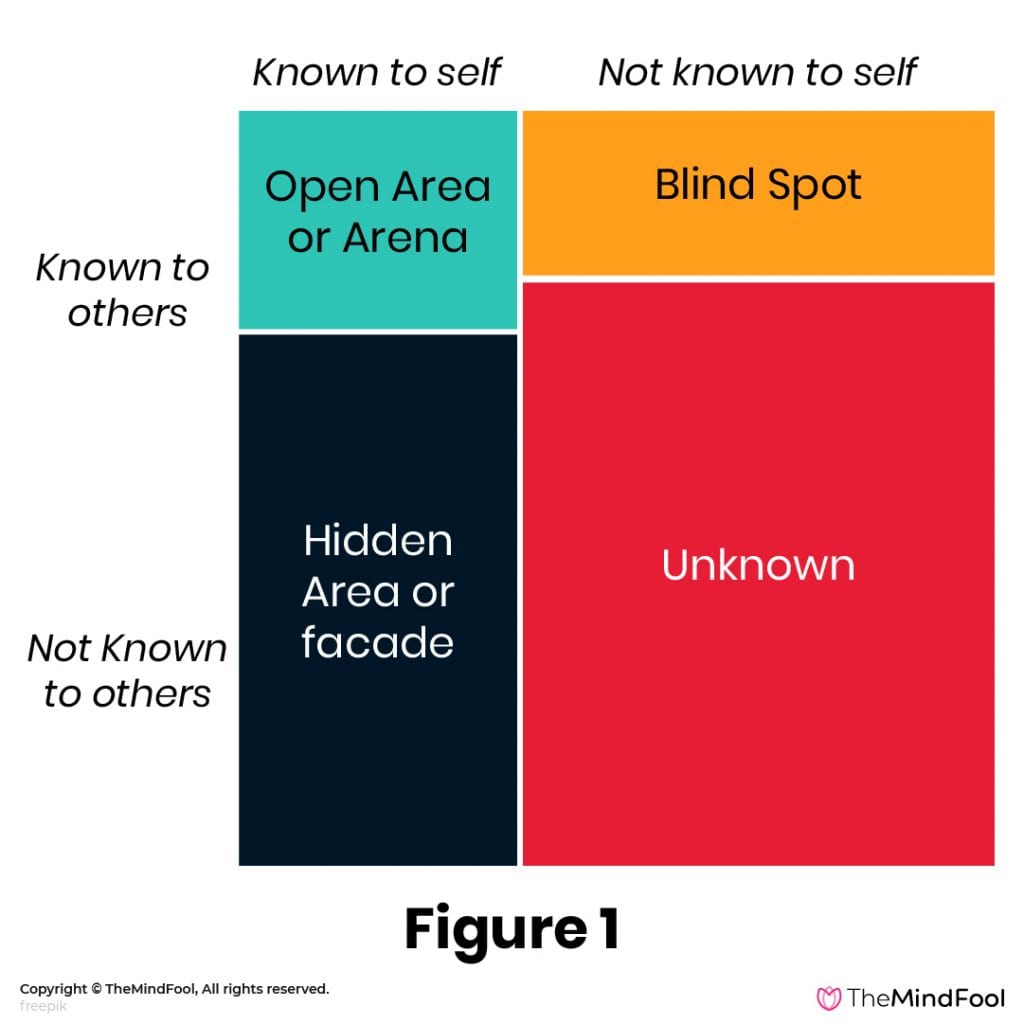
Now, these aspects are quite dynamic depending on how much you disclose, discover, and receive feedback, how much people observe and give feedback, etc. For instance, the more you reveal to others, the more hidden, blind, and unknown areas will start moving to the open areas.
Here’s a detailed explanation with the Johari model depicting how the other quadrants can be converted to the open area.
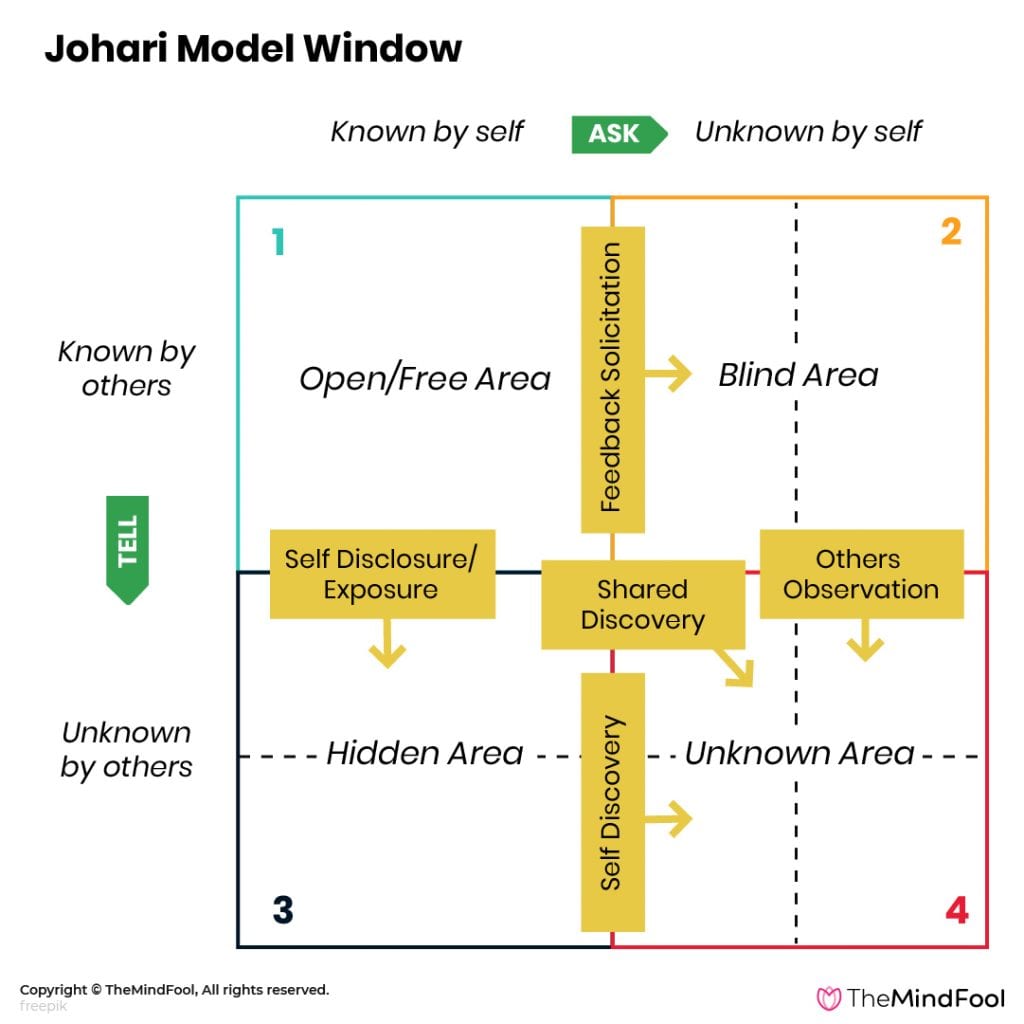
Example 2: An Established Member within a Team/Organization
But if you are working in the organization for several years now and have applied the above-stated methods during the process – your open area will now be larger than any other areas. Further, it has also made the unknown and hidden areas smaller.
However, with the open area, the blind spots have also increased, now that people will observe you closely and might know things about you that you are yet to discover.
This Johari Model is a depiction of any established member of the team.
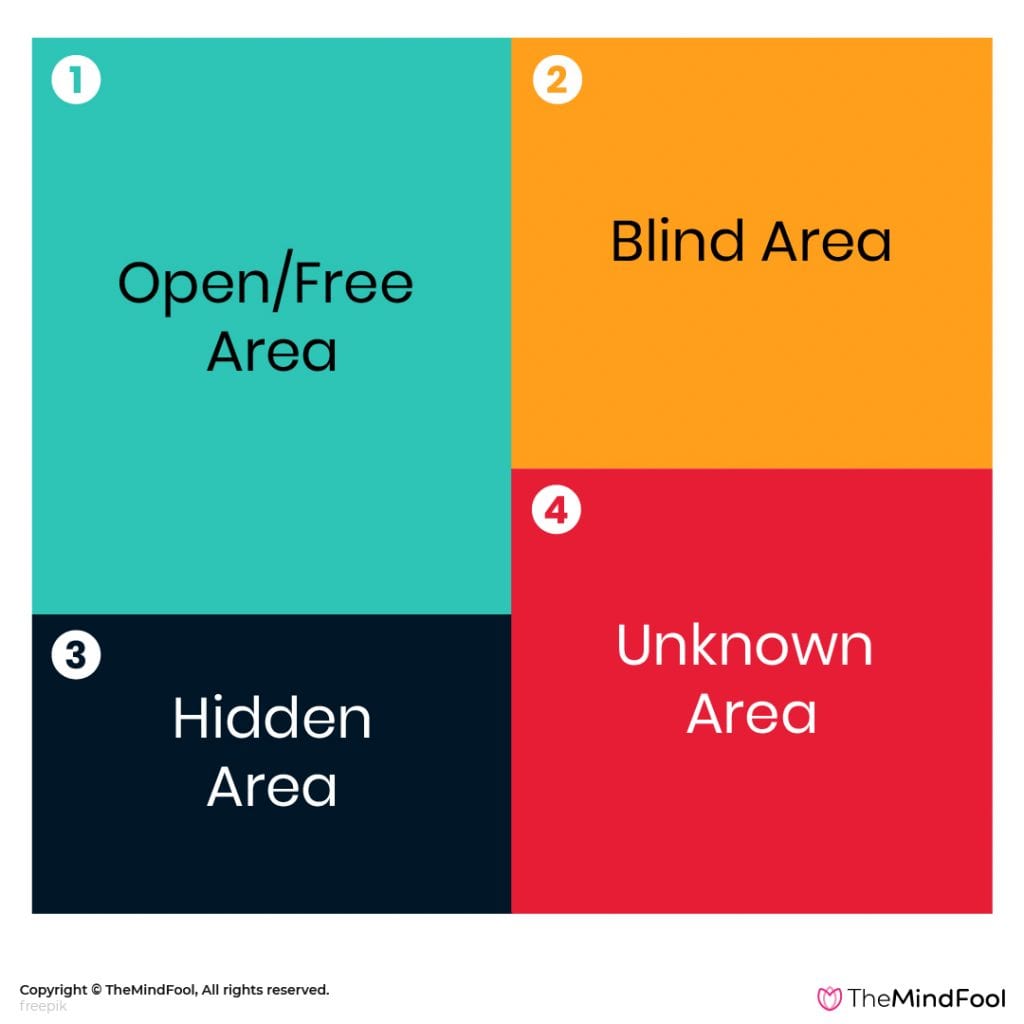
All that said and done. I am sure, you are still asking this question:
How the Johari Window Model Works?
As discussed above, the Johari Window Model helps understand the difference in perceptions – primarily between how you see yourself and how others see you.
This tool or model requires you to collect your own thoughts about yourself and from others via self-discovery and feedback solicitation. This information is then attempted to populate in 2*2 matrix depending on what is known to self and what is known to others.
The overlapping and the sizes of the quadrants then helps analyze the disparity in opinions.
Sometimes, even different groups use teh Johari WIndow Model. In that case, ‘self’ would be your group and ‘others’ would be all the other groups.
Now that you know the ins-and-outs of the Johari model, it’s time to finally discover….
How to Discover your Johari Window?
Every individual has his own Johari window. So, if you want to create your own, and make the most out of it, you need some –
- Honesty
- Peers
- Trust
Along with that, here’s a step-by-step guide to help you draw your own Johari Window.
Step 1: Identify your peers
Find out people who you can trust. They can be anyone, your team members, members from your group activity, or simply people who you know.
Step 2: Select Your Words
Select 5-10 words that best described you, from the Johari adjectives list (mentioned below) and encircle them.
Step 3: Seek Feedback
Now, ask your chosen people to do the same, i.e., select 5-10 words each that they think best describes you.
Step 4: Plot the Selected Words
Once you have received the feedback, you need to plot your words depending on the region it belongs to. For instance, the words selected by both you and others will go to the “open” pane but the words that only you selected should go to the “hidden” pane.
Step 5: Plot the received Feedback
The words that you didn’t select but others did, plot them on the “blind” area. If you want, you can also choose to leave the blind pane empty. Now, place the remaining words in the list to the “Unknown” pane.
Step 6: Review your Window
Review time! Take a close look at all the four window panes, explore the differences and evaluate yourself. How open are you to others? What part of yourself you didn’t know?
After knowing the procedure, here are few things that you must know about finding your own Johari window.
What are the words you should use?
Here’s a list of 56 words that are most commonly used as Johari adjectives. You can either use this for the activity or also create a list of your own.
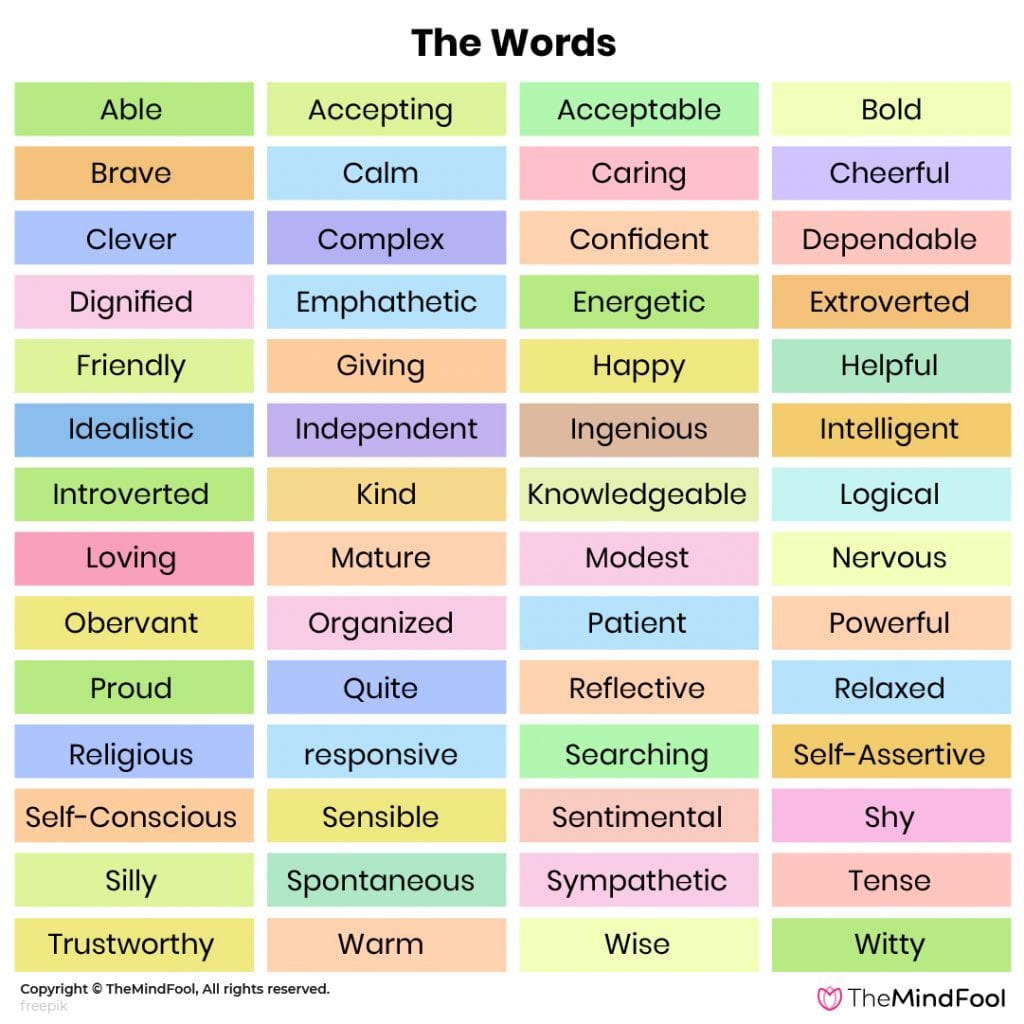
NOTE
If you are creating a list of your own, make sure you give enough variety so that you and others have a diversity of traits to choose from.
How will your window look?
By the end of the activity, you will be able to clearly see the overlaps between the different panes in your Johari Window. This is nothing but the difference between how you see yourself and how others see you.
The relative sizes of the different quadrants will depend on various factors like:
- Your seniority in the team
- The amount of information you have disclosed
- How perceptive are others of you?
- The time you spend with others
…and several others. You might also have to repeat the exercise a few times to finally get the perfect Johari Window.
Remember, irrespective of the quadrants, you should aim at maximizing the open area alongside reducing the others. The more open you are, the better it is for you – helps in increasing self-awareness, promotes interpersonal development, and also builds trust.
What are the next steps?
Once you’ve completed the activity, it’s time to start working on your window in a manner that it helps increase the area of your open window pane and reduces the other windows. Here are a few suggestions to give you a kick-start:
1. To reduce Hidden Pane
Check your hidden area and see if there’s more that you would like to discuss or reveal about yourself to others, also known as self-disclosure.
2. To reduce Blind Pane
Check your blind area and attempt to seek feedback from others to learn about how others perceive you, also known as feedback solicitation.
3. Share your Window
You can also share your completed window and plans with peers and other group members to seek further feedback about how you can move towards the open area.
All this was for when you are working on yourself as an individual, but what about when in a group?
What can you do when in a group?
The activity that we discussed above is an individual activity but that doesn’t imply that it can’t be a group activity.
In a group setting, bring together all of your peers in a physical environment or on a virtual screen and ask them to select the words from the Johari adjectives for each of the group members.
The people taking part in the activity can now collect the feedback and use it to create its own Johari Model. Further, if you want, you can also discuss this window and the game-plan ahead among yourselves.
In the end, here are some
Drawbacks of Johari Model
Nothing in the world is perfect, neither is Johari Model. Here are a few drawbacks of this elegant and potent model
- While the Johari Model asks you to communicate everything, sometimes, it’s better to not communicate certain things.
- Some organizations have a very open and accepting culture but a few others have a conservative and defensive working model. For them, the Johari Model can sometimes prove to be harmful as the individuals take the feedback offensively further damaging groups’ productivity.
- Few people also find the feedback received difficult to manage, which affects their mental health and overall progress.
- Some people may also use the disclosed information in a negative way or may also further pass this information to others without your consent.
Before you go…
Parting Message from TMF
Remember, like every other team activity, you might get different results every time you perform this activity.
But that’s because of the progress in the due course.
However, it will be wise to only consider the results as a means of guidance… and not an objective truth!
Surabhi has a deep passion for words. She puts her heart and mind into whatever she pursues and craves for creative ventures. She has always been keen on creating original content that can make a difference. In her experience as a content writer, she has had the opportunity to work on several fields with Psychology being her favorite. Surabhi says, words have the power to transform the world, better than a sword. So she hopes to contribute her bit to this revolution. At TheMindFool, she feels lucky to have the opportunity to share content capable of bringing about a change in the lives of the readers.
